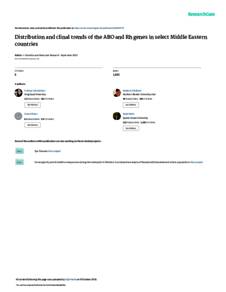وثيقة
Distribution and clinal trends of the ABO and Rh genes in select Middle Eastern countries.
المعرف
DOI: 10.4238/2015.September.9.12
المساهمون
الناشر
Fundacao de Pesquisas Cientificas de Ribeirao Preto.
ميلادي
2015-09
اللغة
الأنجليزية
الملخص الإنجليزي
An understanding of the ABO and Rh blood group systems is important for blood transfusions and is also pertinent due to their potential association with certain morbidities and susceptibilities to infections. To investigate the diversity and differentiation of the ABO and Rh loci in Middle Eastern populations, data from twelve representative Middle Eastern populations were analyzed. Six populations were in conformity with Hardy-Weinberg equilibrium at the ABO locus. The pooled heterozygosity at both loci was calculated to be highest in the sample from Jordan and lowest in Bahrain. Heterogeneity was pronounced in the Northern compared to the Southern Middle Eastern populations. Overall, the absolute gene diversity was 0.0046 and gene differentiation was calculated to be 0.0100. Genetic diversity of the studied loci across all populations (HT) was estimated to be 0.4594, while the diversity within the populations (HS) was 0.4548. Nei's genetic distance analyses revealed highest affinities between the populations of Kuwait and Qatar, Oman and Yemen, and between Qatar and the United Arab Emirates. These results were displayed through a UGPMA dendrogram and principal component analyses, which established clustering of certain populations. Clinal trends of the allelic systems were observed by generating contour maps that allow a detailed appreciation of the distributions of alleles across the geography of the Arabian Peninsula and the Middle East. Taken together, these analyses are helpful in understanding the differentiation of blood group loci and for designing prospective studies for establishing the associations of these loci with health variables in the populations studied.
المجموعة
ISSN
1676-5680
URL المصدر
قالب العنصر
مقالات الدوريات

